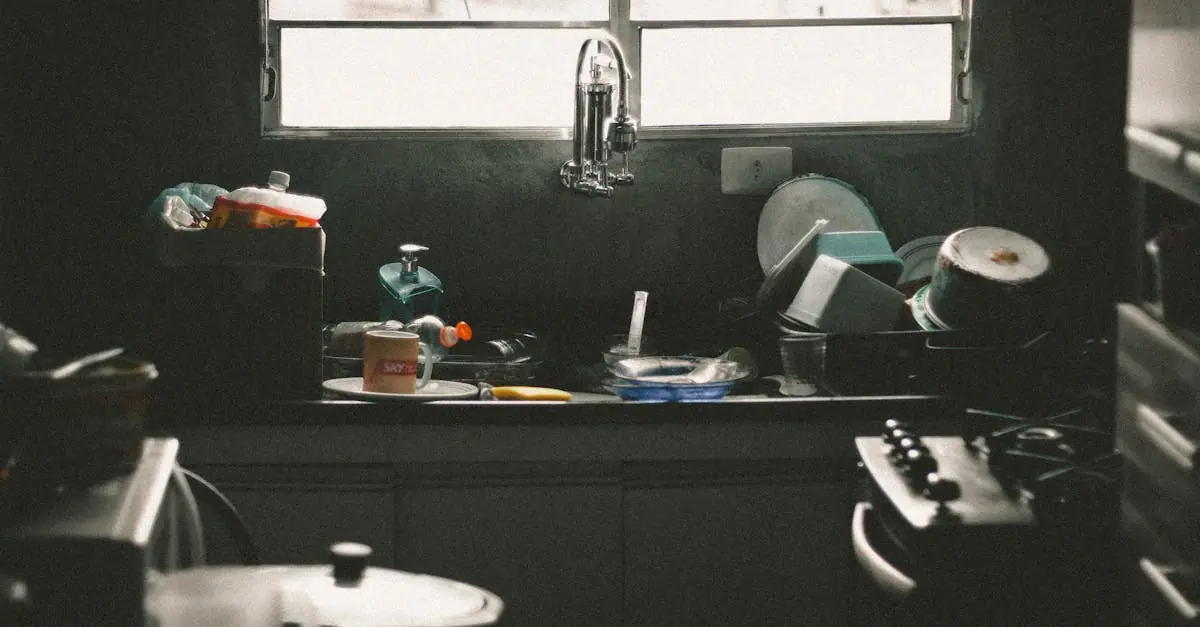Kitchen cabinets often bear the brunt of spills, splatters, and the occasional mysterious sticky substance that defies explanation. If they could talk, they’d probably demand a spa day! Thankfully, with a few clever kitchen cabinet cleaning hacks, they can shine like new without breaking the bank or your back.
Table of Contents
ToggleOverview of Kitchen Cabinet Cleaning Hacks
Kitchen cabinets require regular maintenance to avoid buildup from spills and stains. Effective cleaning hacks can simplify this process and restore the cabinets’ shine.
Baking soda acts as a natural abrasive, removing tough stains with minimal effort. Combine it with water to create a paste, then apply it to stained areas. Use a soft cloth to gently scrub the surface, rinsing with damp water afterward.
Vinegar serves as an excellent degreaser, breaking down grease easily. A mixture of equal parts vinegar and water in a spray bottle can work wonders. Spray the solution directly onto the cabinets, let it sit for a few minutes, and then wipe clean with a microfiber cloth.
Olive oil not only conditions wood cabinets but also adds a beautiful shine. A small amount on a cloth will do the trick. Rub it into the wood grain to enhance the finish without leaving residue.
Lemon juice brings both cleaning power and a pleasant scent. Combine it with vinegar for an extra boost against tough grease.
Lastly, regularly wiping down cabinets with a damp cloth can prevent grime buildup. Daily maintenance saves time and effort for deeper cleaning sessions later.
By using these affordable and simple hacks, maintaining kitchen cabinets becomes straightforward and efficient.
Essential Cleaning Supplies
Select the right cleaning supplies for effective kitchen cabinet maintenance. Using suitable products simplifies the cleaning process and enhances results.
Natural Cleaners
Baking soda acts as a gentle abrasive, perfect for tackling tough stains. Vinegar excels at cutting through grease when diluted with water. Olive oil conditions wood cabinets while providing a natural shine. Lemon juice, when mixed with vinegar, enhances cleaning power and leaves a pleasant scent. Essential oils can add aromatic benefits while offering antibacterial properties. Collecting these natural cleaners ensures a safe, eco-friendly approach to maintaining kitchen cabinets.
Store-Bought Cleaners
Numerous store-bought cleaners target specific cabinet materials and finishes. All-purpose cleaners often work well for everyday dirt and grime. Specialized wood cleaners offer protection and nourishment for wooden surfaces. Degreasers provide powerful solutions for greasy, heavy-duty stains. Disinfecting wipes offer convenience and effective sanitation for quick cleanups. Choosing the right store-bought cleaner can enhance cleaning efficiency and ensure cabinets remain in top condition.
Step-By-Step Cleaning Hacks
Cleaning kitchen cabinets requires a systematic approach for optimal results. These steps ensure a thorough clean while preserving the surfaces.
Prepping Your Cabinets
Start by removing all items from the cabinets. This allows access to every corner and ensures no obstructions during cleaning. Use a soft cloth to dust surfaces lightly prior to deep cleaning. Check for items that may need relocating or discarding to streamline the process. Next, assess the cabinet material; knowing whether it’s wood, laminate, or metal will guide the cleaning method employed. Mix a cleaning solution using equal parts of vinegar and water for a versatile cleaner that suits most surfaces.
Effective Cleaning Techniques
Apply the solution with a microfiber cloth for gentle yet effective cleaning. Begin at the top and work downwards to avoid redistributing dirt. Focus on areas with stubborn stains, applying baking soda directly for tougher grime. Let it sit for a few minutes before wiping away with a damp cloth. For wood cabinets, finish with a small amount of olive oil on a clean cloth to nourish the surface. Consider using lemon juice for an added fresh scent during cleaning. Rinse your cloth regularly to maintain its cleaning effectiveness.
Maintenance Tips for Clean Cabinets
Maintaining kitchen cabinets involves simple practices that promote cleanliness and longevity. Adopting a consistent routine makes a significant impact on their appearance.
Regular Cleaning Routine
Establishing a regular cleaning schedule prevents dirt accumulation. Every week, wipe down surfaces with a damp cloth to remove dust and spills. Use a gentle cleaning solution made of equal parts vinegar and water for deeper cleans. Prioritize addressing stains as they occur to avoid tough build-up. Monthly, inspect cabinets for scratches or damage, and apply a wood conditioner if needed. Regular maintenance transforms cabinets into a well-kept and inviting part of the kitchen.
Avoiding Common Mistakes
Many people overlook specific areas during cleaning. Focusing on the cabinet doors and handles prevents sticky residues from forming. Neglecting to test cleaning products on a small, inconspicuous area can lead to discoloration. Avoid using abrasive sponges, as they can scratch surfaces. Lastly, skipping regular cleaning sessions invites dirt and grease to accumulate, making it harder to maintain cabinets. Staying aware of these pitfalls helps achieve consistently clean and polished kitchen cabinets.
Maintaining clean kitchen cabinets doesn’t have to be a daunting task. By implementing these simple yet effective cleaning hacks, anyone can restore their cabinets to a like-new condition. Regular upkeep using natural cleaning solutions not only enhances the appearance of cabinets but also prolongs their lifespan.
Establishing a consistent cleaning routine can make a significant difference in preventing grime buildup. With the right approach and products, keeping kitchen cabinets spotless becomes a manageable part of any household chore list. Embracing these strategies ensures that kitchens remain inviting and functional for years to come.



